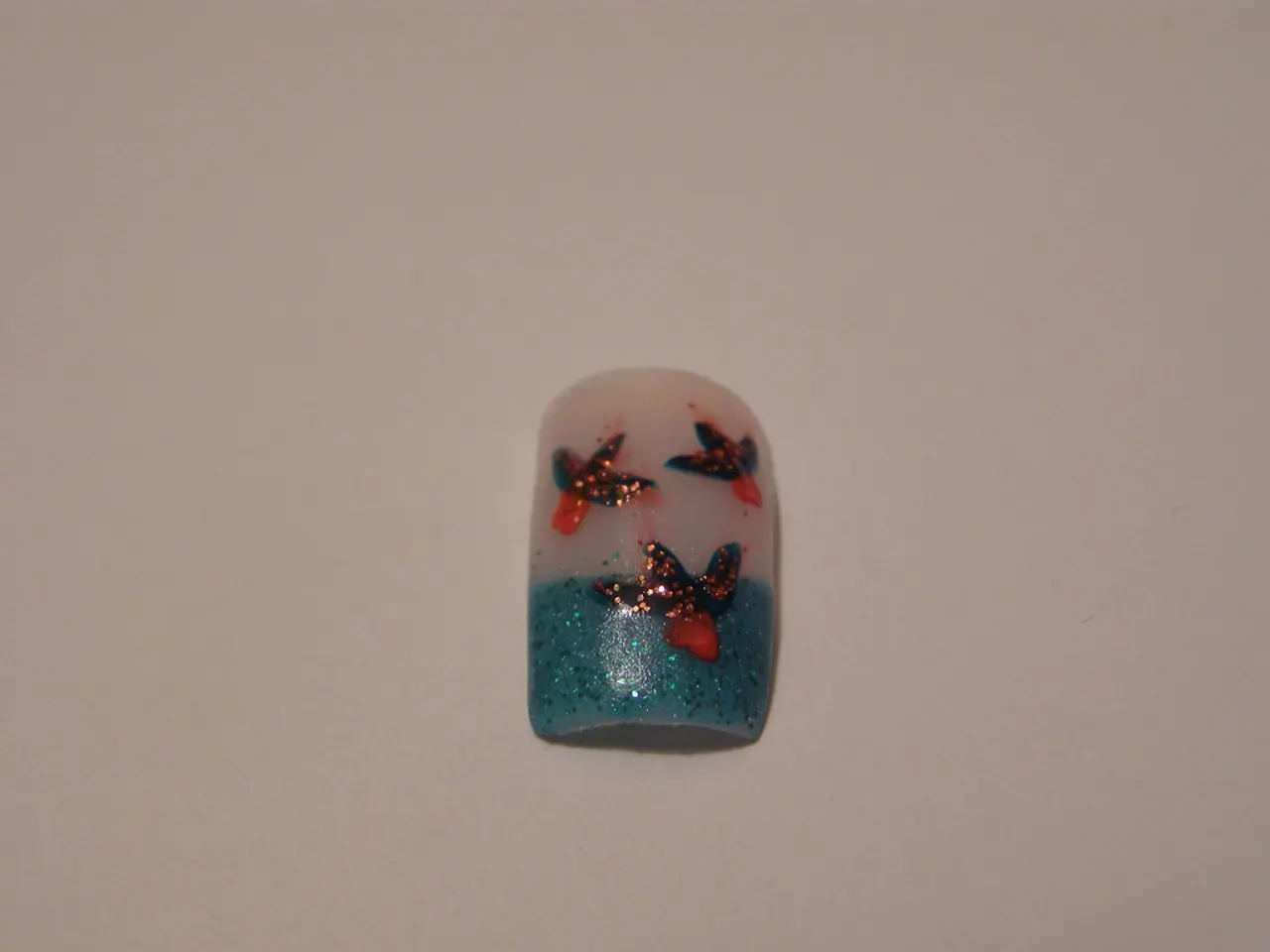Fingernails without any moon crescent shapes: Explanation of the meaning
In the realm of health and wellness, the small, crescent-shaped areas at the base of our nails, known as lunulae, can offer valuable insights into our overall health. A recent study has revealed that changes in lunulae are often linked to systemic illnesses, local nail matrix disturbances, and specific diseases.
One such condition is vitiligo, a chronic skin disorder that causes the skin to lose colour, which can also affect the nails, including the disappearance of lunulae. On the other hand, Wilson's disease, a genetic disorder affecting copper metabolism, can result in the absence of lunulae or bluish discoloration known as azure lunulae.
Anemia, a common blood disorder, is another culprit behind the invisibility of lunulae. This condition, which can be caused by various factors including sickle cell anemia, exposure to toxic chemicals, and kidney failure, can cause an oxygen deficiency that makes the lunulae disappear. People undergoing dialysis for kidney failure often do not have half-moons on their nails due to anemia caused by kidney failure.
Chronic stress, malnutrition, and certain traditional health frameworks also play a role in the disappearance of lunulae. In some cases, the nails can reveal information about blood circulation, nutrition status, and the functioning of various organs in the body, acting as an early alarm for potential medical issues.
Other conditions, such as poor circulation, swelling, cirrhosis, silver poisoning, and yellow nail syndrome, can also cause the nails to be yellow and the lunulae to disappear. Malnourishment, due to extreme diets, medical conditions, or eating disorders, can also cause changes in the nails, including the disappearance of lunulae.
However, it's important to note that the absence of lunulae does not always indicate a serious medical condition. In some cases, the lunulae may not be visible on the thumbs. If a person has no lunulae and no other symptoms, they should not worry unduly.
In contrast, if changes in lunula appearance are observed, a medical evaluation is warranted to assess underlying health issues. Blood tests can detect vitamin and mineral deficiencies, including a vitamin B-12 deficiency, which can cause the lunulae to disappear and nails to turn brownish-gray.
Seeking medical attention for any changes in the nails or skin can help a doctor detect serious medical conditions as early as possible, enabling prompt treatment. For instance, lung and heart diseases can cause the lunulae to turn red, serving as a potential early warning sign.
In conclusion, the lunulae, the visible portion of the matrix under the nails, can provide health clues. By understanding the various factors that can influence their appearance, we can take proactive steps towards maintaining our health and wellbeing.
- In health and wellness, lunulae, the crescent-shaped regions at the base of fingernails, offer insights into systemic illnesses and specific diseases.
- Vitiligo, a chronic skin disorder, can affect the nails, potentially causing the disappearance of lunulae.
- Wilson's disease, a genetic disorder, may lead to the absence of lunulae or azure discoloration.
- Anemia, a blood disorder, is related to the invisibility of lunulae due to oxygen deficiency.
- People undergoing dialysis for kidney failure often have no lunulae due to anemia caused by the failure.
- Chronic stress, malnutrition, and traditional health frameworks can impact the visibility of lunulae.
- The nails can reveal information about blood circulation, nutrition status, and organ function, potentially indicating early signs of medical issues.
- Other conditions like poor circulation, swelling, cirrhosis, silver poisoning, and yellow nail syndrome can cause yellow nails and the disappearance of lunulae.
- Malnourishment due to extreme diets, medical conditions, or eating disorders can lead to changes in the nails, including the disappearance of lunulae.
- The absence of lunulae does not always indicate a serious medical condition; in some cases, they may not be visible on the thumbs.
- If a person has no lunulae and no other symptoms, they should not be overly concerned.
- Changes in lunula appearance should prompt a medical evaluation to assess underlying health issues.
- Blood tests can detect vitamin and mineral deficiencies, including a vitamin B-12 deficiency that causes the lunulae to disappear and nails to turn brownish-gray.
- Seeking medical attention for changes in nails or skin can help detect serious medical conditions early, allowing for prompt treatment.
- Lung and heart diseases can cause the lunulae to turn red, serving as a potential early warning sign.
- The medical industry continues to explore the predictive science of lunulae and their relationship to various medical-conditions and chronic-diseases.
- Scientists researching respiratory-conditions, digestive-health, eye-health, hearing, and cardiovascular-health are among those studying the significance of lunulae.
- Lunulae may offer insights into autoimmune-disorders, neurological-disorders, and environmental-science factors related to health and wellness.
- Climate-change, mental-health, and skin-conditions are areas where further study on the role of lunulae is necessary.
- The lunulae's connection to fitness-and-exercise, nutrition, and industry standards surrounding health-and-wellness is an intriguing area for further research.
- The influence of technology, artificial-intelligence, and data-and-cloud-computing on the study of lunulae and their relation to health is also relevant.
- Changes in the lunulae may reflect relationships, lifestyle choices, and fashion-and-beauty habits, offering insights into personal-growth and self-development.
- Lunulae may be linked to skin-care, food-and-drink preferences, and investing strategies in the finance industry.
- Wealth-management and home-and-garden practices may impact the appearance of lunulae, offering clues to overall health.
- Businesses, personal-finance, and gadgets could play a role in future studies of lunulae and their relationship to health and well-being.
- Cybersecurity, environmental-science, and business ethics are additional areas where the impact of lunulae requires consideration.
- The entertainment industry, including movies-and-tv, celebrities, music, politics, pop-culture, and sci-fi-and-fantasy, may influence lifestyle choices that impact lunulae.
- General-news and crime-and-justice topics can indirectly affect lunulae and their connection to health and well-being.
- Learning and education-and-self-development may provide insights into understanding the significance of lunulae and their relation to various medical-conditions and disorders.
- Data from the lunulae could support career-development in the medical, scientific, and technological fields by offering predictive insights for diagnosing and treating medical issues.
- The role of lunulae in health and wellness extends to pets, travel, cars, books, and social-media usages and their impact on lifestyle choices and personal health.
- Understanding the connection between lunulae and health can lead to advancements in the medical, scientific, and lifestyle industries, as well as personal-growth and self-development.
- By embracing the integration of science, technology, and personal wellness, we can use insights from lunulae to enhance our health and well-being in the modern world.
- In focusing on the relationship between various aspects of our lives—from finance and fashion to personal-finance and lifestyle choices—and the health of our lunulae, we can strive for a more holistic approach to health and wellness.





